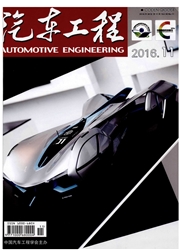

 中文摘要:
中文摘要:
针对大中型客车中复杂噪声源对场点的贡献量不能完全代表该噪声源对车内整体噪声贡献量的问 题, 提出了-种衡量多输入对多输出贡献量的方法.首先对某型客车车内噪声进行频谱分析, 得到车内噪声信号特 征, 计算怠速工况下不同噪声源对不同场点的偏相干函数.接着通过车内声学模态试验, 分析了该客车车内空腔声 学固有频率.最后, 基于偏相干函数提出了“ 贡献系数和” 和“ 总贡献系数和” 两个新的评价参数, 并结合声学模态 特征, 评价进排气、 发动机和冷风扇等各关键噪声源信号对整车噪声的贡献量以及相互之间的影响, 确定了主要的 噪声源和需要改进的噪声频段, 为有效降低车内噪声提供了指导方向.
 英文摘要:
英文摘要:
In view of that the contribution of complex noise source to the noise of field points can not com-pletely represent the contribution of that noise source to the whole interior noise of a large or medium bus, a methol- ogy for measuring contributions of multi-input to multi-output is put forward. Firstly through spectrum analysis,the signal features of interior noise of a bus are obtained,and the partial coherence functions of different noise sources to different field points under idling condition are calculated. Then the natural frequency of interior cavity is analyzed by acoustic modal test. Finally, “contribution coefficient sum” and “ total contribution coefficient sum” ,as two new evaluation parameters based on partial coherence function are introduced,by which and combined with acoustic mo-dal features,the contributions of noise sources such as air induction, exhaust,engine and cooling fan to the overall interior noise of bus,as well as the influences of each other are evaluated,and the main noise sources and corre-sponding frequency bands needed to modify are determined,providing a gaidance for the effective attenuation of inteior noise of bus.
 同期刊论文项目
同期刊论文项目
 同项目期刊论文
同项目期刊论文
 期刊信息
期刊信息
